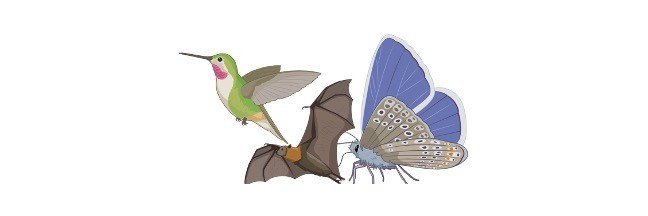-

Binary Fission: Definition, Diagram, and Examples
Continue ReadingBinary Fission Definition
Binary fission is a kind of asexual reproduction in biology that occurs when a parent cell divides into two identical cells, each with the ability to expand to the size of the original cell.
The term asexual refers to reproduction that takes place without the need for sex cells (gametes). Instead, the somatic cells go through an asexual process that results in a parent clone. Because the offspring’s genome is identical to the parent’s, it is referred to as a clone. Binary fission is quite prevalent among prokaryotes, such as archaea, eubacteria, cyanobacteria, and certain protozoans (e.g. amoeba).
Process of Binary Fission
Prokaryotic cells and certain protozoans reproduce by binary fission. The outcome is an offspring with the same genome as the parent, similar to other mechanisms of asexual reproduction such as budding and the creation of baeocytes (e.g., in the cyanobacterium Stanieria).
Binary Fission in Prokaryotes
Prior to cellular division, the DNA in the prokaryotic cell is tightly coiled. The procedure begins with the creation of a genetic material duplicate. The chromosomes then partition to different poles of the cell, a process known as “karyokinesis.”
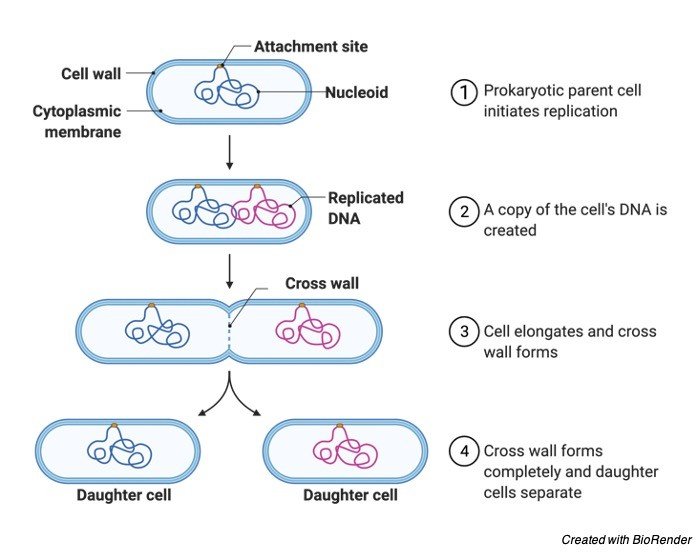
The cytoplasm is then split in half by a new cell membrane, which forms (cytokinesis). If the original (parent) cell has one, a cell wall develops as well. The cytoskeleton FtsZ frequently forms a “Z-ring” when the new cell wall develops.
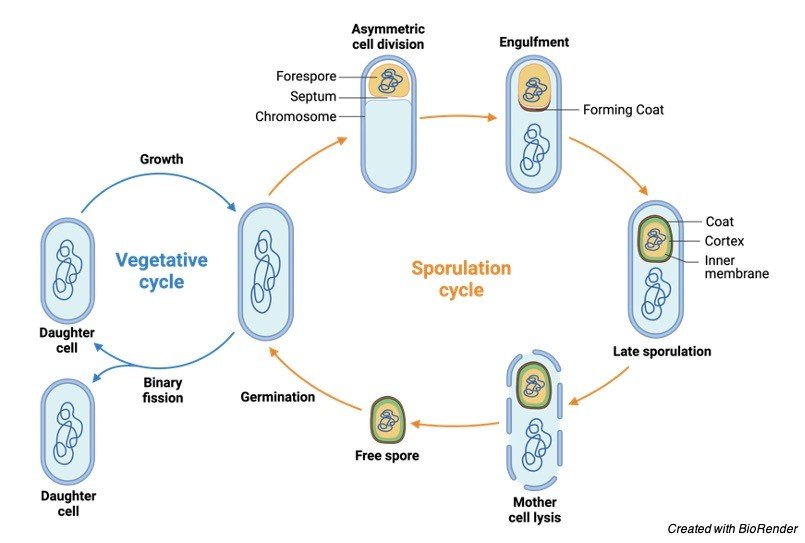
A bacteria undergoing cell fission is seen in the diagram above. The mechanism of bacterial replication looks to be quick and easy, as illustrated. The steps of genomic replication, chromosomal segregation, and cytokinesis in a bacterial cell are as follows: (1) genomic replication, (2) chromosome segregation, and (3) cytokinesis.
Binary Fission in Eukaryotic Cells
Although eukaryotes commonly reproduce sexually, some can also reproduce asexually. Eukaryotes that may reproduce by binary fission include protozoa. One of the primary organelles of eukaryotic cells, mitochondria, divides via binary fission. A prokaryotic fission is comparable to this process. This is one of the foundations of the Endosymbiotic hypothesis, which proposes that basic prokaryotic cells developed into the mitochondria we know today.
Types of Binary Fission
Binary fission may be classified into four kinds based on how the cell divides: irregular, transverse, longitudinal, and oblique.
i. Irregular: The cell splits into any plane in an irregular binary fission. However, it is typically perpendicular to the direction of nuclear division (karyokinesis).
ii. Transverse: Cell division happens along the transverse axis in the transverse-type, thus the name.
iii. Longitudinal: The cell splits lengthwise into longitudinal binary fission.
iv. Oblique: Cell division occurs obliquely in oblique binary fission, which can be left or right oblique.
Binary Fission vs Mitosis
Binary fission is similar to mitosis in that it results in the formation of two identical daughter cells at the end of the process. They do, however, differ in a number of ways.
Mitosis is largely used for growth in multicellular organisms, whereas binary fission is used for reproduction.
Prior to mitosis, the genetic material is duplicated, whereas binary fission occurs during this stage. Spindle fibres are also one of the characteristics that distinguishes mitosis. The spindle fibres connect to the chromosomes and transport them to opposing poles, dividing them into two equal sets.
As in binary fission, the new cells following mitosis will not be a new person. They will transform into a somatic cell that will either differentiate into a specialised differentiated cell or divide mitotically to produce a new set of cells.
Binary fission is a process that occurs in a variety of species. Bacteria, for example, employ it as a method of reproduction. Bacterial fission includes chromosomal replication, chromosomal segregation, and cell splitting, as previously stated. Protozoa are another category of creatures that reproduce through binary fission.
The process of protozoan fission is comparable because it involves similar essential phases. Protozoa, on the other hand, vary from prokaryotes in that they have mitochondria that must be replicated and split. Their cell division patterns differ. In amoebae, for example, cytokinesis can occur in any plane. As a result, their binary fission is of the irregular kind. Euglena is an example of the longitudinal-type. Ceratium, on the other hand, is a protozoan that undergoes oblique cytokinesis. Paramecium is an example of a protozoan with transverse-type binary fission.
Binary Fission Citations
Share
Similar Post:
-

Chlorophyta: Definition, Characteristics, and Examples
Continue ReadingChlorophyta Definition
The word originates from a Greek word meaning green plant. Chlorophyta is the family of green algae, belonging to the domain eukaryote. There are more than 4300 species of Chlorophyta. They are found in land, terrestrially as well as they thrive in extreme climatic conditions such as extreme heat, extreme cold and salty conditions. These species have chlorophyll a and b, carotenoids not in all, flagella, energy resource is carbohydrate in the starch form.
Chlorophyta Classification
Chlorophyta consists of the green plants of the domain Eukaryota of Kingdom Plantae. In Chlorophyta there are further two phylum; Chlorophyta and Charophyta. Those species which reside in fresh water are said to be Charophytes, whereas those residing in marine water are called as chlorophytes, however in few cases they are also found in fresh water and on land as well as in extreme heat, cold and salinity. Example is Trentepohliales for terrestrial species of chlorophytes.
According to the first taxonomic classification, there are around 7000 species of green algae known. There are 4300 species of Chlorophyta in the second taxonomic classification. Reducing the 4300 species from 7000, the remaining ones are the charophytes, which were thought to be chlorophytes. Chlorophyta has further been grouped into various classes such as Chlorophyceae, Prasinophyceae, Ulvophyceae, Pleurastrophyceae, Bryopsidophyceae, Charophyceae, Zygnematophyceae by Mann, Hoek and Jahns system.
Another classification was made in which chlorophytes were separated from charophytes and charophytes were placed into streptophyta by Lelieert. As the study moves ahead, it should be kept in mind that classification will keep on changing as discovery of new species would bring newer classification system.
Chlorophytes and Charophytes
The pigments found in both the green algae are chlorophyll a and b. Cell wall is made up of cellulose. Their food is stored in the form of starch. It is assumed that embryophytes have risen from charophytes, due to similarity between these two class, which is absent in Chlorophyta. Both these group possess certain enzymes such as flagellar peroxidase, glycolate oxidase, aldolase class 1and Cu/Zn superoxide dismutase, which chlorophytes lack. In cell division, phragmoplast have been used in charophytes.
Chlorophyta Characteristics
Chlorophytes are green algae and as the name suggest, they are green in color due to the presence of chlorophyll present in the thylakoid. They also have other pigment such as xanthophyll and β- carotene. Depending from species to species they can be unicellular or multicellular. They possess flagella which is for the movement.
The mode of reproduction is both sexual as well as asexual. Sexual reproduction can occur through conjugation, where genetic material gets exchanged is seen in chlorophytes. Isogamy, another sexual type of reproduction which can also take place between identical parent or oogamy between dis-similar gametes, such as one is motile but smaller in size, whereas the other is large but non-motile.
There are two phases which are seen, in gametophyte haploid phase is seen and in sporophyte diploid phase is seen. If only one gametophyte is involved it is called as haplobiontic, whereas both are involved then, diplobiontic.
Chlorophyta Sub-Groups
Chlorophyta has the following classes and they are:
a) Ulvophyceae
b) Pedinophyceae
c) Chloropicophyceae
d) Mamiellophyceae
e) Nephrophyceae
f) Cholorophyceae
g) Trebouxiophyceae
h) Chlorendrophyceae
Evolution and Phylogeny
As chlorophytes are belonging to the domain Eukaryota, it is presumed that they might have come from eukaryotes when they consumed prokaryotes, which is the endosymbiotic theory. Plastid were formed when prokaryote encapsulated into the eukaryote which formed the organelle and then into a plastid. Similarly, red algae and glaucophytes have risen from the same theory. Thus, many organism have risen from chlorophytes.
Chlorophyta: Biological Importance
Chlorophytes are the major producers due to their ability to carry out photosynthesis, and releases oxygen and starch, which are food source for various other organism such as heterotrophs. Thus, many organism stay in symbiotic relationship with the chlorophytes.
Ex: lichens and fungi. Chlorophytes along with mollusk, ciliates and cnidarians. However, few chlorophytes are non-photosynthetic.
Ex: Prototheca are opportunistic and can cause various disease in humans and animals.
Chlorophyta Citations
Share
Similar Post:
-

Environment: Definition, Types, and Examples
Continue ReadingEnvironment Definition
The word environ in environment means “to surround” and ment means “about”. It is a french word. Environment is not only made up of physical characteristic, but also chemical and biological entities. Thus, the environment comprises of biotic and abiotic factors, which makes up the environment. Thus, leading to the survival, reproduction and evolution of the organism. Thus, the place where living organisms are found along with the other entities is called Environment.
Many times, the word ecosystem and environment are used in conjunction with the other. However, they do differ from each other, as environment is huge. Even nature is used along with environment, however implies both living, non-living entities and man-made entities as well come into it. There are different field in which environment is studied such as ecology which is concerned with the science behind the environment and their interactions.
Types of Environment
i. Internal and External Environment
Environment can be divided into external and internal. The external environment would mean whatever happening outside the organism, whereas internal would be, functions or events going on within an organism is called as internal environment. Internal environment of an organism helps to maintain the balance so that the cell can survive.
ii. Natural and Built Environment
Natural environment is something which is already constructed, whereas built environments are those that are constructed by humans. Example of natural environment would comprise both living and non-living things such as organism, sea, rock, various climate and resources to sustain. Example of built environment would be buildings which were previously made of natural sources available are now made up of concrete, thus altering the environment. Other examples would be artificial lakes, ponds, modern conversion in old agricultural procedures. Not all the changes made by man are detrimental to the environment.
iii. Aquatic, Terrestrial and Atmospheric Environment
The environment can be classified into land, water and air. Water will further be of two types; fresh water and salt water. 97% of life originates from water. Thus, marine environment is the most abundant environment, which is beneficial to humas due to various resources they contain which are of medicinal value, in cosmeceuticals, nutraceuticals, consumption purpose and others.
However, they are the ones who get vastly affected due to dumping of garbage into ocean, agriculture runoff and various human activities. On land, there exist 6 types of ecosystem which are tundra, grassland, desert, forest, rainforest and taiga. Terrestrial environment is not that huge as they lack water and thus, the temperature keeps on changing to maintain the balance and water availability. The most important factor for the survival of all is air.
Changing climate, light, humidity are the parameters to which humans have adapted. Thus, as animals have to adapt to survive, similarly humans to adapt as well for survival. The source of air the green algae which carries out photosynthesis, thus producing oxygen which is required by living organism for their survival.
External Components of Environment
It comprises of both living and non- living things and are:
i. Air, Land, and Water
The outer layer of the earth is called as Lithosphere, which is the hard surface, and arises due to magma solidification. The most abundant and vitally important is Water. It is found in sea, oceans, ponds, lakes, rivers occupying 71% of earth’s surface.
They have both fresh as well as salty water. Salt water is found in oceans and sea, whereas freshwater is found in river which keeps on flowing and moves towards the other river and then to ocean or sea. However, few rivers end up drying because their water flows to the ground. Thus, there is a cycle in which water flows and is glacier water moves to the rivers, further which is distributed to the springs, ground water and small streams.
Streams are quite necessary as they connect to the other points and continue the cycle. Ponds are small water bodies which aren’t deep and can be manmade as well as natural.
Example of manmade can be fish and solar pond. Lakes are water bodies deeper than ponds but not connected to any other water body, but are present in places where mountains or glaciers are present. Humans have constructed dams for the storage of water, although these dams are source of electricity, they however interfere with the environment and change the direction of animals found in the water and the water flow to the forest also gets inhibited, thus, it affects the food chain and destroys the forest.
The most important constituent for survival is atmospheric air, consisting of various gases such as nitrogen, oxygen, argon, carbon dioxide and other inert gases along with water vapor and crystals of ice. To protect the earth from UV rays, there is ozone in the atmosphere, so that radiation does not damage the organism on earth. Thus, atmosphere possess its own components to maintain homeostasis.
Global warming can be defined as the temperature increase due to gases such as chlorofluorocarbon, methane, carbon dioxide and etc. Human activities such as cutting of trees leading to excess of carbon dioxide, thus increasing the temperature and causing global warming. Weather comprises of all the climatic conditions taking place at a particular place.
However, weather and climate are two different words. Climate says more about the atmosphere around, whereas the weather gives us the value of temperature. Humans play a pivotal role in the fluctuation of temperature and weather condition as well due to man-made activities.
ii. Biosphere
Biosphere comprises of all the living things such as protist, eubacteria, archaea, plants, animals, fungi and other living entities. There are around 3.7 billion organism on planet Earth. The habitat where these organism reside is called as Biosphere. Each organism differs from each other in their appearance, metabolism, structure, reproduction and its adaptations. Thus, biomes are a group of organism which can survive in varying geographical conditions.
Biomes are of two types. Land biomes are forest, tundra, grassland and desert. Freshwater and marine water are the two types of water biomes. They play a role in determining how environment changes and how to adapt as well as evolve to the geographical location.
Ecological Role of Environment
i. Energy Flow
In an ecosystem, flow of energy takes place in the environment forming a cycle between the biotic and abiotic factors. All the organisms reside in unison and the energy flows and the cycle is continued. Producers obtain energy from sun and prepare food which is consumed by the primary consumers and then those are consumed by secondary consumers and then by the tertiary consumers and finally gets decomposed and lost in the form of heat.
ii. Biogeochemical Cycles
b) Movement of chemicals from biotic to abiotic, involves the role of biogeochemical cycles. These cycles are required for the elements such as nitrogen, oxygen, carbon, phosphorous and water. All these elements helps in maintaining the cycle to proceed so that in case of carbon and oxygen cycle, equilibrium of both the gases are maintained in the environment.
Challenges
Due to manmade exploitation, a lot of challenges the environment has been facing, which directly or indirectly affects the biotic and abiotic entities. Thus, to reduce its impact on environment, a movement has been initiated called Environmentalism. It deals with pollution, animal and forest extinction, climate change and etc. The main objective is to preserve those species and organisms which are at the verge of extinction. To protect the species, to use natural resources wisely, stop deforestation and global warming.
Environment Citations
- Microplastics in aquatic environment: characterization, ecotoxicological effect, implications for ecosystems and developments in South Africa. Environ Sci Pollut Res Int . 2020 Jun;27(18):22271-22291.
- Microplastics in the environment: A critical review of current understanding and identification of future research needs. Environ Pollut . 2019 Nov;254(Pt A):113011.
- Microbiology of the built environment. Nat Rev Microbiol . 2018 Nov;16(11):661-670.
Share
Similar Post:
-

Natural Selection: Definition, Principle, and Examples
Continue ReadingNatural Selection Definition
Natural selection can be defined as the process in which the organisms learn to adapt to the changes in the environment, due to unfavorable condition. Those organism who can adapt to the changes will survive for a longer duration and reproduce quite a number of offspring. With different adaptations, organisms will acquire traits, that will get passed on to other generations and will differentiate that organism from the others.
Natural selections comprises of two things, producing offspring and surviving in various condition according to Urry. With each organism differing from one another, and with various changes happening, the way these organism keep surviving and produces more offspring will make them more dominant and their genes, thus leading to longer survival.
As changes will keep on happening, organism will have to keep adapting and keep surviving and this way only the evolution process will continue to move on.
What is Natural Selection?
Natural selection can be explained with the help of an example when the organism are well adapted to their environment and suddenly due to unfavorable condition, their offspring will have to adapt to the changes so that they can survive and pass their traits to the other generation and the cycle continues is the what natural selection is.
Only those organism that have adapted will be able to reproduce and continue the process of evolution. Even in two species there will be difference and these differences are the one’s that will help them to reproduce further, other wise it would lead to the end of their species.
Without the natural selection, organism would not have the ability to adapt and to pass on that traits to the others where they have to fight for resources, territory and others. The one’s who survive will have more offspring, which helps them to thrive with limit requirements.
Organisms with genetic variations will survive longer and reproduce more than the one with less variation and will move on further due to their higher chance of survival, mating and reproducing.
History of Natural Selection
The natural selection theory was given by Charles Darwin when he was on a trip travelling the world from 1831-1836. While travelling he observed that same animals show variation in appearance and habitat, which he later termed as adaptations. But before Darwin put up his work there were various theories as well.
Pre-Darwinian Theories
a). Jean Baptiste Chevalier de Lamarck (1744- 1829)
This was the very first theory to be proposed and this man was an advocate who came up with the concept of spontaneous generation, which was that living things arise from non-living things on their own and further turn into complex forms for survival. Lamarckianism was also his theory which was acknowledged and said that evolution happens due to transfer of traits which help to adapt better and for longer survival. The ultimate goal of evolution is human race.
He said that adaptations to be inherited requires the parent to adapt to the changes in a better manner than the others. This can be explained with an example of giraffes. Giraffe’s ancestors were believed to have short neck. To obtain food which was leaves from trees, they stretched their neck leading to longer neck in each generation. Thus, change was seen in the body shape.
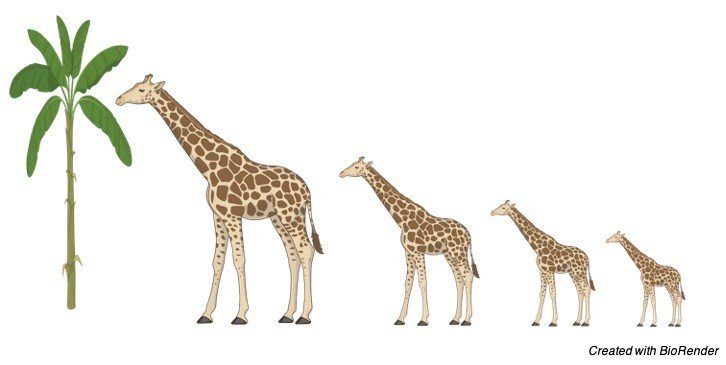
Another example is that of egrets and heron who had short legs, but due to stretching their legs have evolved in tall legs. Another concept that Lamarck thought was possible is new organ development which could develop the function of the previous one.
However, is no longer believed due to upcoming of various new theories, but he made the first step towards the start of the evolution.
b). George Cuvier (1769-1832)
George was the pioneer of who made a documentary on extinct animals. He also did not agree with Lamarck’s theory, but did belief that there was some sort of ancient life. He was a dinosaur expert and believed species couldn’t change.
Another pre-Darwinian theory was catastrophism, which said that earth was a hot ball of lava, which eventually cooled., which was opposed by Charles Lyell and came up with the concept Uniformitarianism which said rather than the huge catastrophe, earth had undergone a slower process. These processes are deposition, weathering, lithification and others which changed the earth as we can see it now.
George Cuvier and Charles Lyell did not accept the idea of Charles Darwin; however, it was proved in the 1860, which was later accepted by Lyell, but George Cuvier was already dead by that time. All the catastrophic events have affected the biological evolution.
Darwin’s Theory
Charles Darwin observed a variation in the organism appearance and other patterns. For example, birds of the Galapagos Island are quite different from each other as in some have huge and rigid beak, whereas others have sharp and thinner beak. However, Darwin was unaware that these birds were similar to each other, after he confirmed it with an ornithologist.
This different changes in the finches were the adaptations made by them to survive, forming novel species. Thus, Darwin gave the evolution theory by natural selection. The theory states that offspring arise from the parent species and they keep on adapting over time. Thus, the ancestors become the same, but its generations keeps on adapting thus, forming a new species.
Charles Darwin theory is one of the most acknowledged theory, which has two parts. The first one say that all forms of life are linked to each other. Due to diversification, some characteristics are chosen over the other is the second part which forms Charles Darwin’s theory of natural selection.
Traits are Heritable: This statement means whenever an organism has acquired some trait due to unfavorable conditions, it can reproduce and pass it to the next generation so that the characteristics try to come out in consequent generation.
Traits Inherited in Offspring Helps Them to Compete for Resources: With the characteristics inherited in the subsequent generation, they have more chances of survival and can reproduce once they have acquired any trait which can be further passes on so that they can fight for resources, territory and other requirements.
Huge Number of Offspring, then the Environment can Take Care of: If this is the scenario then, it would lead to competition and depletion of resources very quick. Less food, area, mating partners and other resources.
Principle of Natural Selection
Natural selection primarily relies on the environment and supports only those characteristics that are important to reproduce and to survive. It is not necessary that traits which are beneficial to one maybe important to others as well. On the basis of the traits visible, natural selection takes place. Variations in the organism could be seen due to mutations or other changes. The 4 main principles of Charles Darwin are which are seen his book “Origin of species”
Variation: Variation in organisms can be seen in height, weight, color, appearance, behavior, traits and other characteristics. Some organism might show less variation while others may show more, thus differing from the population. Ex various colors are seen in one type of moths. Moths which can camouflage to the color of the tree bark is also a variation, which will pass on to other generation and thrive and make more offspring.
Inheritance: Traits that are favorable for survival are usually passed on to the other generation. Natural selection would take place only if a trait has been affected by environment. Thus, unfavorable traits will not be seen much whereas the favorable one will be selected. Ex finches of Galapagos shows quite a variation in the beak and are thus chosen by natural selection. Thus, only those organism which have made adaptation will pass on the traits to the other traits to the generations coming.
Huge Population Growth: As the organisms produces large number of offspring than it can take care of, leading to competition and resources getting depleted. Thus, the mortality also increases due to scarcity of resources, and only those who can get out of it survive and reproduce. For example, fish produces millions of eggs in one go, however only few survive. However, they have large number of people who catch fish, thus a greater number of fishes, higher the chances of survival. Thus, the one that survive, passes on their genes to the others.
Reproductive Advantage: As the beneficial traits have been passed on the upcoming generation, thus, those traits might be seen in the whole generation. Ex the huge tail of peacock is for attracting their partners. Thus, being a reproductive advantage. The camouflage ability of a moth on the tree bark from prey is a survival advantage. Another reproductive advantage is when plants increases their pollens. Other advantages choosing partner, mode of reproduction, child care so that it offer advantages further are the various other pros.
Principle of Evolution
There are 4 principles of evolution and they are:
i. Competition
With every generation the number of offspring usually increases, thus it leads to competition within the organism for resources. Those who obtain the resource, survive and produce offspring to pass on the traits. Competition is of two types; intraspecific and interspecific. In intraspecific, members of the same group fight against each other. Example two lizards fighting for the mating partner. Such competition is seen for adaptation within a population. In interspecific, competition is between two different species. Ex two different species fighting for food. In such competition, one species might get extinct.
ii. Heritable Differences
Differences in trait can be found in different individual, which can be important or non-beneficial. Thus, the beneficial one will survive and further pass the traits. Heritability can be defined as the amount of variation seen in a particular trait, which is said to be same for a given population and changes with time. For example, Due to the smoke released from the chimney, tree barks changes color to a dark color. Moths which are darker in color can camouflage to the trees whereas the lighter moths cannot thus have more chances of getting hunted.
iii. Survival of the Fittest
For the survival and reproduction, variation is very important as the traits will play the role to allow the survival and reproduction. Thus, fitness which can also be referred as strength, intelligence comes into picture. For example, incase of peppered moth, which are dark in color, thus are more capable of adjusting and will longer and keep on reproducing than the light-colored moths.
iv. Descent with Modification
This is seen when a species has been isolated from the other one with the same ancestors, but forms a new species. Thus, here diversity of traits will make them novel from others. Example turtles on a low area have shorter neck than turtles of the Galapagos Island. Thus, the turtles with longer necks will be chosen because of their adaptation. In case of any calamity such as drought, the one with a longer neck are more capable of surviving and producing than the other. Thus, the traits will be passed to the other generation, with change in the species. This can be called as descent with modification.
Natural Selection Types
i. Stabilizing Selection
It can be defined as selecting the trait that is neither too favorable or unfavorable, instead selecting the intermediate of both is called as Stabilizing selection. For example, plants which is shorter in height will receive less light, whereas the plant which is tall have chances of getting broken by the wind, thus, intermediate height plant will be perfect. Thus, the characteristic expressed here later would be plants of medium size, which is not of a significant value but an average one but allows the reproduction to continue.
ii. Directional Selection
Due to the environmental change the organism has also shifted to other direction to protect itself from getting preyed. Example peppered moth in England were previously light in colors, due to light colored trees, however due to industrial smoke settling on trees and becoming darker in color. The moth shifted to darker color to protect itself from getting hunted, thus all the moth adapted this change for survival. Thus, environment change directly affects the others and thus, they have to adapt to the change making it directional.
iii. Diversifying or Disrupting Selection
This type of selection protects both the sides of variation, however is harmful to the intermediate one. For example, oysters which are light colored are not visible much and dark colored oysters mix with the color of rocks. However, intermediate colored are more susceptible to preyed by crabs. Thus, the other two types will survive and reproduce. Such type of selection are called as polymorphism.
iv. Sexual Selection
As the name suggests, organism should have a trait or a characteristic so that they are preferred over the other one. For example, Due to a mutation, Drosophila flies have yellow-colored bodies than the normal grey color flies. Thus, females will choose yellow- colored male flies over the normal one. Another example are male deer which have antlers and the one who has nice antlers has the chances of succeeding and getting the mate. The main objective of selecting a partner is to mate and to have offspring.
v. Predator- Prey Selector
Predator is the one that hunts down and prey is the organism which gets killed. Thus, prey will have some mechanism to prevent itself from getting hunted such as camouflage, chemical, mechanical and behavioral. Thus, when the prey feels, they might be in danger, they will release certain chemicals to protect itself and change its shape. Another example is chameleon which changes color to protect itself from predators. Thus, these organism tend to become more defensive whereas the predators understand the tricks and tries other ways. Thus, adaptation is happening in both scenario. However, if an organism is unable to cope up then it might be extinct.
vi. Kin Selection
In this type of selection, those traits are chosen which are beneficial to all members. For example, bees although cannot produce offspring, they spend their whole life making the hive, thus the characteristic of these bees will be incorporated into the queen, thus when she produces offspring indirectly.
Natural Selection Examples
a) Black furred vs tan furred mice: There are two types of mice such as black mice and tan mice. However, in night and as rocks are black in color, black mice are not visible, thus, hawks can easily find the tan mice and will be consumed by the hawk, but not the black mice. Thus, tan mice will extinct and large number of black mice would survive and the trait inherited is fur color. Its an example of descent with modification.
b) Long tailed vs short tailed peacocks: The long tail of feathers is the characteristic to attract mate and to stop predators from going away. Thus, long tail peacocks produce more offspring than the one with short tailed. Thus, the trait will be passed on and all the peacocks will have plumage and with the change in the color of tail of peacock, it became known that peahens prefer bright colored plumage.
c) White, black and brown mice: Evolution happens due to natural selection. White colored are visible to the predators; thus, their trait will not move to the next generation. Brown and Black colored mice can camouflage; thus, their traits will pass to upcoming generation.
d) Long vs short neck giraffes: Few giraffes have short neck whereas the others have longer necked. Due to some calamity, if shorter plants are unavailable, then giraffes with short neck will not be bale to survive, thus only long neck giraffes would survive and reproduce and pass the traits.
e) Gray vs green tree frogs: On the tree barks both these types of frogs will be found. As grey colored tree frogs can better camouflage, thus have more chances of surviving from the predators such as snakes and bird and its trait will be passed down the generation to come. Thus, treefrogs have been favored in this selection.
f) Red vs green bugs: the bugs which are hunted in this case is red bugs, by the birds, thus they will get extinct within few years and the green bugs will multiply in number and produce more offspring.
g) Penguins, flightless birds: Penguins are swimmers, which helps them in hunting food and run from the predators. However, there is no land availability, thus their predator and food will be present in water.
h) Venus flytrap: In plants as well, natural selection occurs. They are found in soil, where nitrogen is absent and are carnivores. For their survival, they trap insects which have nitrogen, thus it becomes a source for plant to thrive.
i) Sharks: Sharks to protect themselves have defense mechanism, the top side is blue- grey in color, whereas the beneath is white colored. This color change helps them to camouflage in water, where someone looking from down finds it blue in color and white color is balanced by the light coming from the water.
j) Green and brown beetles: Since the ground is brown in color, green color beetles are easily visible. Thus, green one will become extinct and the brown will dominate the green ones during the day, whereas in night brown beetles will be easily spotted. Thus, both the species will be affected depending upon the climatic conditions.
Natural Selection Citations
- A percolation model of natural selection. Biosystems . 2020 Jun;193-194:104120.
- What is adaptation by natural selection? Perspectives of an experimental microbiologist. PLoS Genet . 2017 Apr 20;13(4):e1006668.
- Positive natural selection in the human lineage. Science . 2006 Jun 16;312(5780):1614-20.
- Natural selection in mimicry. Biol Rev Camb Philos Soc . 2020 Apr;95(2):291-304.
Share
Similar Post:
-

Cell Organelle: Definition, Types, and Function
Continue ReadingWhat is Cell Organelle?
Any of the numerous cellular structures that perform a specific job inside a cell is referred to as an organelle. All creatures have a cell that serves as their structural, functional, and biological unit. It is a membrane-bound structure that contains cytoplasmic compartments and structures. Eukaryotic cells and prokaryotic cells are distinguished by the presence of cytoplasmic membrane-bound organelles. A eukaryotic cell is defined by the presence of membrane-bound organelles, whereas a prokaryotic cell is defined by the absence of such organelles.
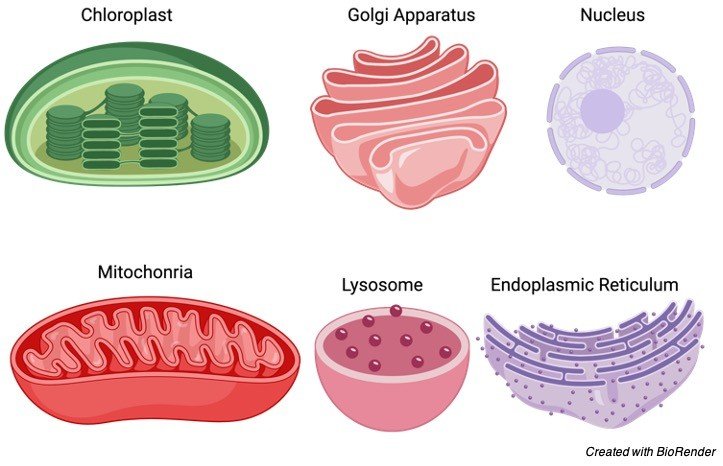
The nucleus, endoplasmic reticulum, Golgi apparatus, mitochondria, and plastids are all organelles bound by a double lipid bilayer in a eukaryotic cell. The plasma membrane and the cell wall are also included. Some sources classify single-membraned cytoplasmic structures such as lysosomes, endosomes, and vacuoles as organelles. The non-membrane-bound cytoplasmic structures, such as the nucleolus and ribosomes, are another less-strict definition of an organelle.
Cell Organelle Definition
Organelle literally translates to “little organs.” The cell, like the rest of the body, is made up of numerous organs that execute specific activities. They are membrane-bound compartments or structures of a cell in general. An organelle, by definition, is a membrane-bound compartment or structure in a cell that serves a specific purpose. In a broader sense, an organelle is any cellular structure that performs a specific function, whether or not it is membrane-bound.
Cell Organelle Etymology
The name organelle is derived from the New Latin organella, which is a diminutive of the Medieval Latin organum, which means “body organ.” Organellar is a derived term that means “pertaining to, related to, or characterised by an organelle.”
Cell Organelle vs Inclusions
The living components inside the cell are known as organelles. Cell inclusions, on the other hand, are non-living elements found inside the cell. The term “non-living” refers to the fact that the inclusions do not perform the biological functions that organelles do. Fat droplets, glycogen, and pigment granules, such as melanin, lipofuscin, and hemosiderin, are all included.
Eukaryotic vs Prokaryotic Organelle
The nucleus, endoplasmic reticulum, Golgi apparatus, mitochondria, and chloroplast are just a few of the organelles found in eukaryotic cells (plastids). Not all of these organelles, however, are located in a single cell or organism.
Plant cells, for example, have a lot of chloroplasts, while animal cells don’t. According to the endosymbiotic hypothesis, there are organelles that have their own DNA separate from the nucleus and are thought to have arisen from endosymbiotic bacteria. Mitochondria and plastids are the organelles in question.
Prokaryotes, which were previously thought to lack organelles, have lately been shown to have their own type of “organelle.” However, they are sometimes referred to as proteinaceous micro-compartments rather than genuine organelles in other sources. The Carboxysome (a protein-shell compartment in some bacteria for carbon fixation), chlorosome (a light collecting complex in green sulphur bacteria), magnetosome (found in magnetotactic bacteria), and thylakoid are examples (in some cyanobacteria).
Types of Cell Organelle
An organelle, according to some sources, is one that is surrounded by lipid bilayers. They include the nucleus, endoplasmic reticulum, Golgi apparatus, mitochondria, and plastids, according to this definition (e.g., chloroplasts). Ribosomes and nucleosomes are not considered organelles in this sense, since they are not confined by membranes. Similarly, because they are single-membrane confined cytoplasmic structures, lysosomes and vacuoles do not qualify as organelles.
Animal Cell Diagram

Other sources, on the other hand, are less restricted. An organelle is a specialised component of a cell that has a defined purpose. Organelles may be divided into two categories: membrane-bound organelles (which include both double-membraned and single-membraned cytoplasmic structures) and non-membrane-bound organelles (also referred to as biomolecular complexes or proteinaceous organelles).
Plant Cell Diagram
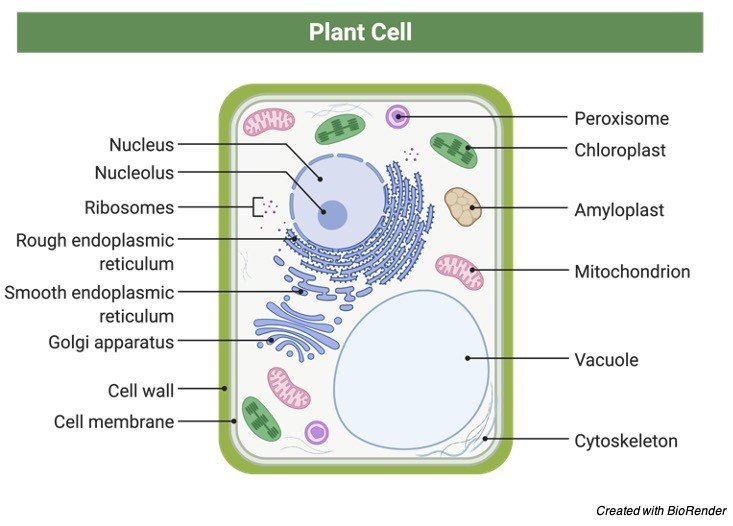
I. Membrane Bound Organelle
Membrane-bound organelles are cellular structures that have a biological membrane that binds them together. The membrane is generally made up of a single or double layer of lipids with interspersed proteins. The nucleus, endoplasmic reticulum, Golgi apparatus, mitochondria, plastids, lysosomes, and vacuoles are all membrane-bound organelles.
i. Nucleus
The nucleus is an organelle that regulates gene expression and is important for preserving DNA integrity as well as governing cellular functions such as metabolism, growth, and reproduction. Because of its relatively large size and usually spherical form, the nucleus is one of the most visible components in a cell. A nuclear envelope, which is a lipid bilayer perforated with nuclear pores, holds it together. However, some cells do not have a nucleus. At adulthood, red blood cells, for example, shed their nucleus to increase their affinity for respiratory gases like oxygen. Multiple linear DNA molecules are arranged into structures called chromosomes inside the nucleus.
ii. Endoplasmic Reticulum
The endoplasmic reticulum (ER) is a double-membrane organelle that is important for protein and lipid synthesis, glucose metabolism, drug detoxification, and intracellular transport, among other things. The rough ER and the smooth ER are the two kinds of ER. The surface of the rough ER is studded with ribosomes, whereas the smooth ER is devoid of bound ribosomes. Both kinds are made up of labyrinthine, interconnecting flattened sacs or tubules that run through the cytoplasm and may extend to the plasma membrane.
iii. Golgi Apparatus
The Golgi apparatus is a double-membraned organelle that is involved in glycosylation, secretion packing, lipid transit throughout the cell, and the formation of lysosomes. Membrane-bound stacks make up the structure.
iv. Mitochondria
Mitochondria (singular: mitochondrion) are double-membrane-bound spherical or rod-shaped organelles with their own genome, making them semi-autonomous. They are primarily responsible for the production of ATP via cellular respiration.
v. Plastids
Plant cells contain plastids, which are double-membrane-bound organelles found in photosynthetic cells. Chloroplasts, chromoplasts, and leucoplasts are the three kinds of plastids. Chloroplasts are photosynthesis-related plastids that contain green pigment. Chromoplasts are plastids that include colours other than green. Leucoplasts are pigment-free plastids that have a role in food storage.
vi. Lysosomes
Lysosomes are cytoplasmic organelles with a single membrane and a significant number of digesting enzymes. They have a single membrane and are largely responsible for the digestion and removal of extra or worn-out organelles, food particles, and ingested viruses or bacteria.
vii. Vacuoles
Vacuoles are membrane-bound vesicles in a cell’s cytoplasm, particularly in plants. They help with structural support, intracellular secretion, excretion, storage, and digestion, among other things.
viii. Endosomes
Endosomes are cytoplasmic structures with such a membrane that allow endocytosed molecules to pass through on their approach to the lysosome.
II. non-Membrane Bound Organelle
Organelles that are not membrane-bound yet perform specific tasks are known as non-membrane-bound organelles. Ribosomes, spliceosomes, vaults, proteasomes, DNA polymerase III holoenzyme, RNA polymerase II holoenzyme, photosystem I, ATP synthase, nucleosomes, centrioles, microtubule-organizing centres, cytoskeleton, flagellum, nucleolus, stress granules, and others are examples of non-membrane-bound organ
Cell Organelle Function
Each of the organelles has a particular function.
Nucleus: It is responsible for preserving DNA integrity and managing cellular functions such as metabolism, growth, and reproduction.
Mitochondrion: Through the process of cellular respiration, it is responsible for producing the majority of the cell’s adenosine triphosphate supply.
Plastids: Food storage and photosynthesis are two functions of this organ.
Endoplasmic Reticulum: Protein and lipid synthesis, glucose metabolism, calcium concentration, drug detoxification, receptor attachment to cell membrane proteins, and intracellular transport are all involved.
Golgi Apparatus: Glycosylation, packaging of molecules for secretion, lipid transport throughout the cell, and the formation of lysosomes are all functions of this protein.
Lysosomes: In particular, for digestion and the elimination of extra or worn-out organelles, food particles, and ingested viruses or germs.
Vacuole: Structure support, intracellular secretion, excretion, storage, and digesting are all functions of this protein.
Ribosome: Protein synthesis takes place here.
Nucleosome: The chromatin’s fundamental structural unit.
Centriole: Involved in the nuclear division process.
Cytoskeleton: It controls cell shape, maintains intracellular structure, and regulates cell mobility.
Cell Organelle Pathology
Nuclear genetic material is stored in the nucleus. Mutations in genes or chromosomes can have negative consequences or cause genetic diseases. Mutations in the mitochondria and chloroplasts’ extranuclear genetic material might also cause unhealthy or dysfunctional situations.
Lysosomal storage disease is a metabolic disorder caused by a malfunction in lysosomal function that results in an abnormal buildup of harmful chemicals in the cell. Lysosomal storage disorders are passed down through generations. The malfunctioning lysosomal enzyme is caused by a mutation in a specific faulty gene.
The nucleus is where genetic material is stored. Gene or chromosomal mutations can have severe repercussions or lead to genetic disorders. Mutations in the extranuclear genetic material of mitochondria and chloroplasts may potentially result in harmful or dysfunctional conditions.
A failure in lysosomal function causes an abnormal accumulation of toxic substances in the cell, resulting in lysosomal storage disease. Storage abnormalities of the lysosome are handed down through the generations. A mutation in a specific defective gene causes the lysosomal enzyme to fail.
Cell Organelle Citations
- Formation of plant cell wall supramolecular structure. Biochemistry (Mosc) . 2010 Feb;75(2):159-72.
- Plant cell wall-mediated immunity: cell wall changes trigger disease resistance responses. Plant J . 2018 Feb;93(4):614-636.
- How Bacteria Subvert Animal Cell Structure and Function. Annu Rev Cell Dev Biol . 2016 Oct 6;32:373-397.
- Shedding light on the cell biology of extracellular vesicles. Nat Rev Mol Cell Biol . 2018 Apr;19(4):213-228.
Share
Similar Post:
-

Oxidation: Definition, Classification, and Examples
Continue ReadingOxidation Definition
Oxidation can be defined as the gaining of an oxygen atom and its reverse is losing an oxygen atom is called as Reduction. Thus, the process in which electrons are lost in a reaction, is called as Oxidation. The reaction in which electrons are gained is called as Reduction.
Oxidation Example
For example, in this reaction, CuO+Mg →MgO+Cu , electrons are gained by copper and lost by magnesium.
Another example could be that of hydrofluoric acid where fluorine is reduced and hydrogen is oxidized, H2+F2→2HF. Thus, to make hydrofluoric gas, hydrogen and fluorine are required.
i). Using oxygen to carry out oxidation: Oxidation using oxygen has been previously done and it is known that the first oxidizing agent at that time was oxygen. However, oxygen is added when there is loss of electron. An example of oxidation is 2Fe+O2 → Fe2O3 In this case oxidation of iron leads to the formation of iron oxide, also known as rust.
ii). Using hydrogen to carry out oxidation: This is the opposite of the oxidation of oxygen. In oxidation there is gain in oxygen and loss of hydrogen, whereas in reduction, there is loss of oxygen and gain in hydrogen atoms. An example is CH3CH2OH → CH3CHO. There is loss of hydrogen as ethanol gets oxidized.
iii). Oil rig chemistry: Oxidation and reduction can be understood with oil rig. “Oil” means oxidation is loss and “rig” means reduction of electrons. It is concerned with electrons only not hydrogen or oxygen. For example, if hydrogen has lost a electron, it has been oxidized (H+). If chlorine gains an electron, it is called as reduced (Cl–). This is called as the oil rig concept.
Oxidation Process
Oxidation and reduction can take place on their own and does not happen hand in hand, but are considered as half- half reactions which completes to form a complete reaction. These reactions tend to possess a charge and the charge needs to be balanced in a reaction as electrons are lost or added in a reaction. Thu, forming the overall net charge.
Oxidizing and Reducing Agents
In a redox reaction, electrons are passed to the oxidant by the one getting reduced. Thus, in such cases, lost electrons will be oxidized by reducing agent and electrons gained will be reduced by the oxidizing agent.
Oxidizers: those substances are called oxidizers which loses electrons or donates electron to another compound is called as Oxidizing agent. Thus, they themselves get reducing by losing an electron. They can be referred to as electron acceptor. Example are O2, F2 of elements such as H2O2 and MnO–.
Reducers: They reduce other compounds by gaining electrons, thus can be termed as reducers or reducing agents. They are referred to as electron donor. Example are iron, magnesium, sodium and others. Reducing agents oxidize themselves by donating electrons to other compounds.
Oxidation Reduction Reaction (Redox Reaction)
A reaction is said to be redox if oxidation and reduction both of them take place simultaneously in a reaction. Example are metal corrosion, photosynthesis, respiration, browning of fruits, burning and others are the example of redox reaction.
Classification of Redox Reaction
Three types of redox reactions takes place and they are:
i). Oxygen Atom Transfer: In this reaction, carbon reacts with mercury oxide to form carbon dioxide and mercury. The charge on mercury oxide was +2 whereas now that charge has moved to carbon dioxide. Thus, carbon is oxidized.
C + 2HgO → CO2 + Hg
ii). Hydrogen Atom Transfer: In this case, hydrogen atoms are removed from hydrazine and transferred to oxygen molecule. Thus, oxygen gets reduced and hydrazine loses hydrogen atoms and thus gets oxidized.
N2H4+O2 →N2+2H2O
iii). Electron Transfer: Zinc and copper react with each other in a solution to form zinc ion and copper metal. Thus, copper gets reduced while zinc gets oxidized. The +2 net charge on copper is transferred to zinc ion.
Stoichiometric Basis
There is no information available on what is the mechanism behind these redox reactions and thus it is said that stoichiometry gives the molecules their characteristics. Therefore, there are stoichiometric redox reaction which contain hydrogen, oxygen and electron transfer.
Oxidation State Change
A few theories have been made on oxidation and reduction. It states that each atom possess a nucleus which has positive charge and electrons which are negatively charged surrounding the nucleus. Thus, maintaining the balance. Thus, when a molecule gains or donates an electron, it obtains an oxidation number showing the electron number which can bind to the other molecules. When a molecules undergoes oxidation or reduction its oxidation state is determined. For example, Fe3+ is the state in which oxygen is present. Thus, +3 is the oxidation state of Fe.
Examples of Oxidation
The only oxidizer which can oxidize all the metals as well as non-metals is oxygen, which forms oxides.
S + O2 → SO2
4Li + 02 → 2Li2O
These are some of the example of oxygen forming oxides.
Oxidation in Chemistry
Metal displacement is a brilliant example of oxidation in chemistry. Metal displacement occurs when one metal occupies the position of other metal. For example,
Zn + CuSO4 → ZnSO4 + Cu
In this reaction, zinc reacts with copper sulphate to form zinc sulphate. It is a redox reaction, where copper get positioned at the place of zinc and copper metal are freed.
The ionic equation can be written as:
Zn + Cu2+ → Zn2+ + Cu
The two half reactions are:
In this reaction copper gets reduced, Cu2+ + 2e- → Cu
In this reaction, zinc gets oxidized, Zn →Zn2+ +2e-
Another example is denitrification, where nitrate is reduced to nitrogen. The reaction is:
2NO3– +10e- +12H+ → N2 + 6H2O
Hydrocarbon oxidation in presence of oxygen will form water and then lead to the formation of alcohol, carboxylic acid, ketone and later form peroxide.
Oxidation in Biology
Redox reaction is important for various biological processes such as photosynthesis and anaerobic respiration. Example of anaerobic oxygen is when glucose is oxidized to carbon dioxide and oxygen gets reduced.
C6H12O6 + 6O2 → 6CO2 + 6H2
For cell respiration the reaction is;
6CO2 + 6H2O + LIGHT ENERGY → C6H12O6 + 6O2
During photosynthesis, to form sugar, carbon dioxide gets reduced to form oxygen. The opposite of photosynthesis results in the formation of carbon dioxide and water. For reduction of NAD+ to NADH, carbon which is reduced can be used.
Oxidation in Geology
The role of redox reaction in geology is for mineral deposition, production and for mobilization of minerals. Whenever the rocks are about to undergo oxidation, their color changes to red. Rock will look white in color or green when, some liquid oozes out of it, which could be uranium. The deposition of such compounds on rocks and marbles are redox reaction examples.
Oxidation Citations
- Bio-inspired Nonheme Iron Oxidation Catalysis: Involvement of Oxoiron(V) Oxidants in Cleaving Strong C-H Bonds. Angew Chem Int Ed Engl . 2020 May 4;59(19):7332-7349.
- Hydroxylamine driven advanced oxidation processes for water treatment: A review. Chemosphere . 2021 Jan;262:128390.
- Recent Advances in Copper Catalyzed Alcohol Oxidation in Homogeneous Medium. Molecules . 2020 Feb 9;25(3):748.
Share
Similar Post:
-

Phenotypic Ratio: Definition, Calculation, and Examples
Continue ReadingPhenotypic Ratio Definition
The phenotypic ratio is the relationship between the number of offspring who will inherit a certain characteristic or a set of traits. This ratio is often obtained by executing a test cross and then analysing the data from that cross to determine how frequently a trait or trait combination will be shown based on the genotype of the offspring.
What is Phenotypic Ratio?
A phenotypic ratio is a quantifiable relationship between phenotypes that shows how often the frequency of one phenotype corresponds with the frequency of another. The phenotypic ratio acquired from a test cross is used by researchers to get gene expression for generations of an organism.
A test cross is a genetics technique for investigating and obtaining the phenotypes and genotypes of organisms’ progeny. An organism’s genotype is its genetic make-up; it displays the alleles and genes that the organism possesses.
The phenotype is defined as the expression of genes and alleles in observable characteristics. Eye colour, height, and even hair texture are all phenotypes. Through a test cross, genotypes may be used to determine the phenotypes of an organism’s progeny and, as a result, the phenotypic ratio.
If a red insect and a blue bug mate, their progeny may be red, blue, or purple in colour (a mixture of both colours). To estimate the number of times a specific phenotype is observed in comparison to another phenotype, we’ll need to calculate the phenotypic ratio.
In layman’s words, phenotypic ratios can help us figure out if an insect is blue, red, or purple. The likelihood of an observable characteristic occurring in cross breeding. Punnett Squares or a phenotypic ratio calculator are the easiest ways to calculate phenotypic ratios.
Genetic Terminology
Before learning how to calculate a phenotypic ratio, you need to be familiar with the following genetic terms:
• Gene: A gene is anything that is inherited from a parent and handed on to their children.
• Allele: A gene variant that is passed down from one of two parents.
• The thread-like structure made up of nucleic acids and proteins that carries the gene is called a chromosome.
• A locus is the exact place on a chromosome where a gene is found.
• Heterozygous: a child who inherits two distinct alleles of the same gene.
• Homozygous: An offspring who inherits the same alleles from both parents for a certain gene.
• Even when it comes into touch with the recessive, the dominant allele will always be displayed as the phenotype.
• Recessive Allele: a gene that only expresses itself as a phenotype when it interacts with another recessive allele.
• Monohybrid: This occurs when two parents are crossed and just one phenotypic is produced.
• Dihybrid: When two parents are crossed, the children have phenotypes that are a mix of the parents’ traits.
• When two parents are crossed, the result is an offspring with a wider variety of traits than a dihybrid.
• Punnett Square: When certain parents are crossed, a square diagram is utilised to identify the genotype of children.
Phenotypic Ratio Calculation
We look at the alleles of the parent organisms and predict how often those genes will be expressed by the offspring to get a phenotypic ratio. We usually know what alleles will express and how they will appear. Punnett Squares or a phenotypic ratio calculator are the easiest ways to calculate phenotypic ratios.
Trait Frequency Ranking Phenotypic Ratio Brown hair 15 2 15 ÷ 5 = 3 Black hair 45 1 45 ÷ 5 = 9 Red hair 5 3 5 ÷ 5 = 1 Phenotypic Ratio Formula
To utilise the phenotypic ratio formula, you must first create a frequency chart, which you may do if you don’t have one already. Identify each desirable attribute and group them into columns. Then count the number of people who have particular features, making sure that each organism is only tallied once. From smallest to largest, the frequencies will be sorted. After that, each frequency will be divided by the least feasible frequency, and the result will be recorded in a separate column in the table.
The phenotypic ratio will be calculated using these responses, which will be rounded off. For example, in Table 1, the final phenotypic ratio is 9:3:1, with 9 representing black hair, 3 representing brown hair, and 1 representing red hair.
Phenotypic Ratio Calculation for Cross Type
A phenotypic ratio calculator created for specific crossings or a Punnett square can both be used. Calculations can be challenging in many cases, since phenotypes are exhibited when many alleles are mixed. The following instances, on the other hand, will use a single allele to generate a single characteristic.
We can get findings for phenotypes that will arise in the first filial generation (F1) of a crossover and subsequent generations using these calculating techniques. We can even predict the many consequences that may occur in later generations. Even without understanding everything there is to know about genetics, early horse and dog breeders knew how to produce animals with various characteristics. This sort of selective breeding has resulted in the enormous diversity of animal varieties that we have today. Some phenotypic ratios are straightforward.
What does it mean to have a 1:1 phenotypic ratio?
When organisms are crossed, there are only two phenotypic options that have a 50/50 probability of occurring, resulting in a 1:1 phenotypic ratio.
What does a phenotypic ratio of 3:1 imply?
This happens when two heterozygous parents each pass on one allele to their children, resulting in two potential phenotypes despite the presence of multiple genotypes. It’s crucial to keep in mind that genotypic and phenotypic ratios aren’t usually equal.
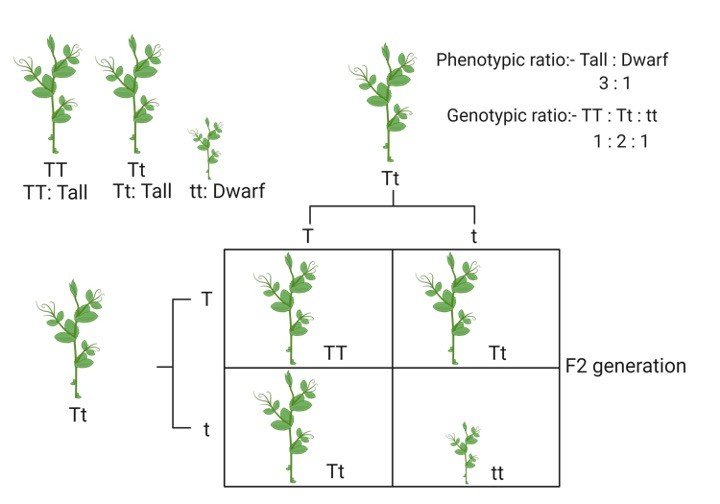
Phenotypic Ratio of Monohybrid Cross
A monohybrid cross occurs when two homozygous parents cross, resulting in just one trait in their offspring. It can also happen when both parents’ genotypes are entirely dominant or completely recessive, resulting in the opposite phenotype for some genetic characteristics. Using a Punnett Square, this may be easily established.
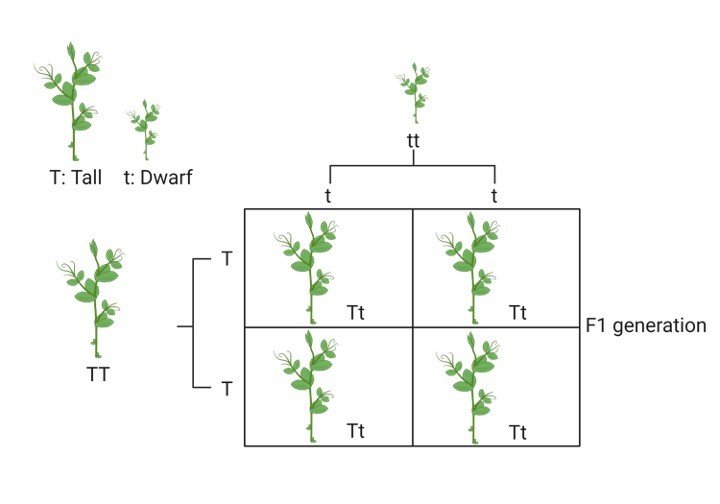

The genotype TT, has the phenotype of a tall tree, whereas the genotype, tt, has the phenotype of a short tree in this case. T is a dominant characteristic, which means that regardless of whether a recessive gene is present or not, the organism will always exhibit its phenotype. The gene is recessive, meaning it can only be seen when it is coupled with another allele of the same letter.
When they breed, each of the offspring will receive one of their alleles to make up their chromosome. Every offspring will be heterozygous since they must inherit one allele from each parent and the parents are both homozygous. Because their genotype is Tt, every offspring they create will grow to be a towering tree. As a result, the phenotypic ratio does not need to be calculated because all four offspring have the same phenotype. Because just one of the two potential outcomes (a tall or short tree) is an observable characteristic, calculating the phenotypic ratio would be superfluous. The phenotypic ratio would be expressed as 3:1 if it had to be shown.
Phenotypic Ratio of Dihybrid Cross
When two phenotypes are involved, dihybrid crossings come into play. However, there is a reason why breeders seldom use only one phenotype. If they do, they will never have the opportunity to investigate other options or build even more distinctive and interesting features. Why raise bigger pigs for more meat if they only get brain defects from both parents? As a result, geneticists continue to seek and promote beneficial breeds while avoiding breeding fewer desirable ones. They can calculate the phenotypic ratio using a dihybrid cross calculator.
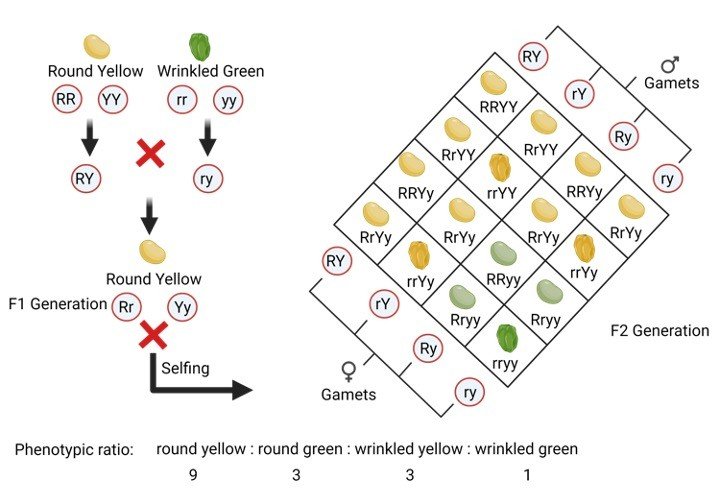
The dihybrid cross between two yellow peas in the F1 Generation is shown in above figure. This cross’s preceding or parent generation consisted of two homozygous parents, one dominant (RR YY) and the other recessive (RR YY) (rr yy). The dominating RR had spherical peas and the colour YY, which was yellow. Wrinkled peas and a yy, green coloration was seen in recessive rr.
A yellow, round pea (RRYY) is crossed with a green, wrinkled pea in the parent crossing (rryy). As a result, all of their progeny are spherical and yellow, resulting in a monohybrid crossing. They are, however, heterozygous for the genes that produce yellow, green, round, or wrinkle alleles (RrYy).
When two RrYy children are crossed, they generate phenotypes that are distinct. They have round (R) and wrinkled (r) alleles, as well as yellow (Y) and green (G) alleles (y).
The use of a Punnett square to identify the offspring’s phenotypes is straightforward and provides a clear picture. The dihybrid Punnett square calculator makes determining the phenotypic ratio simple. Figure demonstrates how simply the genotype frequencies may be counted, yielding a 9:3:3:1 ratio for this hybrid. This may be applied to a wide range of phenotypes.
Phenotypic Ratio of Trihybrid Cross
When a second allele is introduced, the genetic expression and phenotypic possibilities grow even further. The phenotypic ratio for breeds like this one would be calculated using a trihybrid cross calculator. Because of the many different results that may be obtained from trihybrid cross ratios, they can be rather lengthy. Take, for example, the following scenario:
Humans are renowned for having a variety of hair kinds. Geneticists want to explore what happens if they mix individuals with different hair lengths, colours, and textures in one experiment. The dominant A allele results in long hair, whereas the recessive A allele results in short hair. The gene is shown as a dominant B in black hair and as a recessive B in brown hair. Finally, straight hair will be represented by a D and will be the dominant allele, while curly hair will be represented by a d and will be the recessive allele.
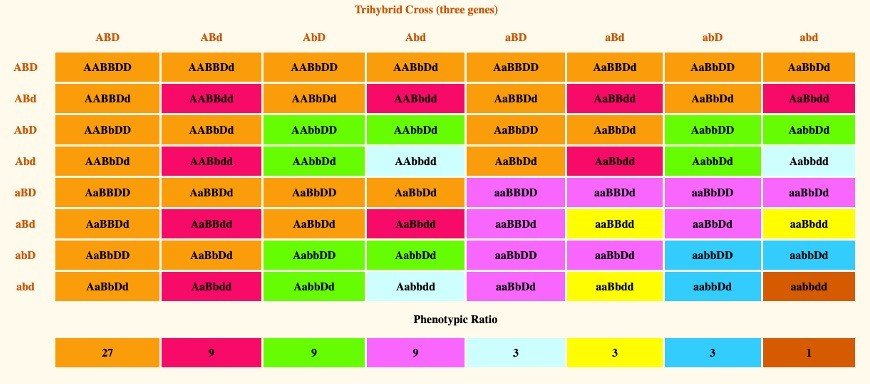
The researchers started with a monohybrid hair length phenotypic cross. They use two heterozygous parents to cross one gene. As previously stated in this article, this results in a 3:1 phenotypic ratio, generating both long and short-haired offspring. Despite the fact that some kids have long hair, they inherit the recessive gene for short hair. Long-haired children have a considerably larger chance of having long hair than short-haired offspring.
A second cross was performed, this time incorporating the hair colour gene. Because the two genes now give way to numerous phenotypic outputs, this dihybrid cross will produce more than two phenotypic results. The phenotypic ratio now stands at 9:3:3:1, with the options being long, black hair, long brown hair, short black hair, and short brown hair. We can observe that when additional genes are introduced into the breeding process, the phenotypes get more complicated.
Finally, the third gene was introduced, which contributes to hair texture. The trihybrid cross-ratio, like the monohybrid and dihybrid crossings, may be calculated using a Punnett square calculator. There are a total of 8 observable characteristics in this phenotypic ratio. All of these elements are mixed in unique ways to generate distinct children.
The most common phenotype will be a dark, long, straight-haired human child with a combination of all the dominant genes. This is due to the fact that once the alleles are joined, the dominant allele always takes precedence. The following phenotypes will be observed:
• hair that is long, straight, and brown.
• hair which is long, curly, and black.
• hair that is long, curly, and brown hair.
• hair is short, straight, and black.
• Brown hair which is short and straight.
• hair that is short, curly, and black.
• hair that is short, curly, and brown.
The phenotype aabbddd is the least frequent, as predicted, because it is the only one that includes all three recessive genes. Only one of the sixty-four (64) potential crossovers has a chance of happening.
These illustrations depict phenotypic ratios using one, two, and three genes, respectively. In actuality, the phenotype is controlled by the interplay of numerous genes (alleles) at multiple loci, making the inheritance of human hair characteristics far more complicated.
Phenotypic Ratio Citations
- Estimation of phenotypic selection differentials for predicting genetic responses to ratio-based selection. Genome . 1988 Dec;30(6):838-43.
- Estimation of odds ratios of genetic variants for the secondary phenotypes associated with primary diseases. Genet Epidemiol . 2011 Apr;35(3):190-200.
- The effect of mating frequency on phenotypic ratios in sibships when only one parent is known. Genetics . 1966 Oct;54(4):1019-25.
Share
Similar Post:
-

Unicellular Organism: Definition, Types, and Examples
Continue ReadingUnicellular Definition
Single-celled organisms are called as Unicellular. Such organisms can also carry out various function such as digestion, absorption, metabolism, excretion and reproduction, with the help of a single cell. Organisms can be unicellular prokaryote and unicellular eukaryote. Bacteria, archaea, protists and fungi are some example of unicellular organism. They can be opportunistic and cause various disease in plants, humans and animals. They have applications in environmental science as well as in medicine.
Unicellular organism contains protoplasm which possess various components such as nucleic acid, proteins, carbohydrates and others. The external and internal components of the organism are separated by cell membrane which is encapsulated by protoplasm; however, interaction is necessary to obtain food and to throw out unnecessary components. Although such organism are single-celled, they cannot be seen with the naked eyes and these unicellular organism can thrive in extreme conditions such as pH, temperature and cold conditions.
Unicellular Organism Examples
a) Phytoplankton: They are found in fresh water and marine water. They are protists which are unicellular. Examples are Diatoms and green algae. When favorable conditions are present, they blossom up, thus, producing large amount of oxygen. They get energy from photosynthesis.
b) Amoeba: They are found within human, dead matter, muddy soil and etc. Amoeba are eukaryotes. They have tentacles also known by the name pseudopods which helps to hunt prey, for locomotion and for other senses.

c) Nitrosomonas and Nitrobacter: These are prokaryotic. They produce a form of nitrogen from carbon or carbon dioxide. The other form of nitrogen is oxidized to form Nitrosomonas. That again gets oxidized to form Nitrobacter. It has applications in agriculture.
d) Euglena: It is a prokaryotic unicellular organism. They are autotrophs as well as heterotrophs. They are known as plant- animal hybrid. They can carry out photosynthesis if they get good amount of light, if not they obtain food from another organism.
Importance of Unicellular Organism
They are of great importance in the field of medicine, for the production of capsules, tablets and others. They also have importance in maintaining the equilibrium of the ecosystem.
i. Ecological Function of Unicellular Organism
Eubacteria have the ability to degrade organic matter, as well as fix the soil content. Pseudomonas species can combat pollution by breaking down the pollutants present in water and soil. Other than Pseudomonas, there are other species also capable of breaking down the pollutant. They have medicinal as well as industrial importance. For example, in making of alcohol, bread, cheese and other consumable products. Antibiotic formulation is another example. Another type of eubacteria is cyanobacteria which can carry out photosynthesis and balance the oxygen level.
ii. Medicinal Importance of Unicellular Organism
Unicellular organism such as archaea also have medicinal importance, such as antibiotic formulation., which are used to cure patients and to clear the resistance issue of the medication.
Types of Unicellular Organism
Unicellular organism can be both unicellular prokaryotes as well as unicellular eukaryotes, which are not visible to the naked and requires a microscope, although their colonies are visible to human eye.
i. Prokaryotes
Prokaryotes are those which lacks nucleus and organelles. The DNA is present in the nucleoid region. Examples are archaea and eubacteria. A way to distinguish between both is that eubacteria have peptidoglycan, whereas the other have pseudopeptidoglycan.
a) Archaea
They are the first found organism on earth. They thrive in extreme climatic conditions such as extreme temperature, methane derived conditions as well as in soil, water and other habitats. The mode of reproduction is binary fission and fragmentation. There is a type of archaea that produces methane are called as methanogens. They take up carbon dioxide to form methane and an energy molecule along with-it. Example ATP.
b) Eubacteria
Also referred to as true bacteria, which can be classified into classes; gram positive and gram negative on the basis of cell wall. In order to protect themselves from outer environment destruction, they produce spores. The mode of reproduction is binary fission and can be opportunistic as well as naturally present in the human microbiota to produce vitamins for the functioning of cells.
ii. Eukaryotes
They contain nucleus as well as organelles like mitochondria, chloroplast and others. They can reproduce sexually as well as asexually. Example of unicellular eukaryotes are Fungi and Protist.
a) Protist
They are unicellular eukaryotes, present in soil and in water. Examples are algae, water molds, protozoans, slime molds. Protozoans can be opportunistic, causing disease in humans such as Plasmodium falciparum causing malaria in humans. They can also be found in the body as natural microbiota. Photosynthesis can be carried out by few protozoans who can make their own food. The mode of reproduction in these parasites are binary fission, budding, schizogony, with a complex life cycle. However, few of them can sexually reproduce. In order to protect themselves from the outer environment, they have capsules.
• Algae: Single-celled organism which can synthesize their own food. They are seen in water, soil, rocks and other areas.
• Molds: Molds survive on dead decayed matter and are found in water which are known as water molds and in appearance are like fungi. When found on surface, they are called as slime molds, which under stress can convert into a multicellular entity.
b) Fungi
They can be unicellular as well as multicellular. Example of unicellular fungi are yeast, present on fruits, dried leaves and in food. It can also turn into opportunistic and cause disease such as Candida albicans, a fungal disease. Yeast can thrive in anaerobic as well as aerobic conditions. The mode of reproduction can be through binary fission and budding.
In anaerobic conditions, it leads to fermentation, thus forming products such as cheese, wine, bread and other dairy products. Fungi have the potential to degrade organic matter and thus form a part of the food chain. They also medicinal importance and culinary importance. For example, mushrooms are consumed world-wide. They also have a role to play in the ecology, the water reaches the roots of the plants when fungi takes up the water and passes it to the roots.
History of Unicellular Organism
Although the organelles present within the cell have same function such as within the nucleus is the DNA present, the energy sources are ATP. This happens due to evolution. However, variations will arise when organism tries to adapt to the unsuitable conditions.
There are three types of domains which are Bacteria, Archaea and Eukaryotes. 3.5 billion years prior, the first unicellular prokaryote fossil was obtained. According to the Endosymbiotic theory, from the prokaryotes, eukaryotes have emerged. This is due to resemblance in the organelles and various functions between the two.
Unicellular Organism Citations
- N 6-methyladenine DNA modification in the unicellular eukaryotic organism Tetrahymena thermophila. Eur J Protistol . 2017 Apr;58:94-102.
- Saccharomyces cerevisiae in neuroscience: how unicellular organism helps to better understand prion protein? Neural Regen Res . 2021 Mar;16(3):489-495.
- Tetrahymena as a Unicellular Model Eukaryote: Genetic and Genomic Tools. Genetics . 2016 Jun;203(2):649-65.
Share
Similar Post:
-

Anaerobic Respiration: Definition, Equation, and Examples
Continue ReadingWhat is Anaerobic Respiration?
Anaerobic (cellular) respiration is a type of respiration that occurs in both prokaryotes and eukaryotes, in which cells break down sugar molecules to generate energy without using oxygen. While fermentation simply requires the glycolysis stage, certain types of anaerobic respiration rely on the electron transport chain system to deliver electrons to the ultimate electron acceptor.
Anaerobic Respiration Definition
Anaerobic respiration is an anaerobic process that converts organic food into simpler chemicals and produces chemical energy (ATP). The electron transport chain mechanism is used by some kinds to convey electrons to the final electron acceptor, which can be inorganic or organic, but not oxygen.
Anaerobic vs Aerobic Respiration
Fermentation is sometimes considered an example or element of anaerobic respiration because they both do not consume oxygen and are anaerobic. Other sources, on the other hand, see them as two distinct processes. In this case, we’ll look at the two processes separately.
The term “anaerobic” means “without oxygen.” This technique of cellular respiration generates energy without the use of oxygen. Because there isn’t enough oxygen for smaller animals to breathe, they must rely on their energy to survive the lack of oxygen. Anaerobic respiration is the process by which they produce the energy they require. In contrast, aerobic respiration necessitates the use of oxygen, which serves as the electron transport chain’s ultimate electron acceptor.
This stage is skipped during fermentation. Pyruvate (in lactic acid fermentation) or acetaldehyde are the final electron acceptors following glycolysis (in alcohol fermentation). The energy from glucose is transformed into a form that can be utilised by the cell or saved for later use in this process. Instead of carbon dioxide and water, it creates lactic acid. This form of respiration is only employed for brief periods of time.
Anaerobic Respiration Equation
Glucose ⇒ Alcohol + CO2 + Energy
The procedure does not result in the formation of any more ATP molecules in the absence of oxygen.
This mechanism is mostly seen in microbes, but it is also found in multicellular organisms like humans, though not as frequently. It’s a transitory response to a lack of oxygen.
Our bodies require a lot of energy during hard or severe exercise like biking, sprinting, cycling, or weightlifting. As oxygen becomes scarcer, muscle cells in our bodies turn to lactic acid fermentation to meet their energy needs.
Anaerobic Cellular Respiration
Anaerobic cellular respiration is similar to aerobic cellular respiration in that electrons are moved along an electron transport chain formed from a fuel molecule, which speeds up the synthesis of ATP. Many microbes employ sulphate (SO42-) as the last electron acceptor, reducing it to hydrogen sulphide (H2S) at the conclusion of the transport chain, while others use nitrate (NO3–) to reduce it to nitrite (NO2–). Other nitrate decomposers can further convert nitrate to nitrous oxide (NO) or nitrogen gas (N2).
Final Electron Acceptor
During cellular respiration, certain living systems utilise an organic molecule (e.g., dimethyl sulfoxide, fumarate, and trimethylamine N-oxide) as the final electron acceptor. An inorganic molecule is utilised as a final electron acceptor in other living systems. Sulphate ion (SO4–2), nitrate (NO3–), and ferric ion (Fe3+) are examples of inorganic compounds.
Here are some examples of anaerobic respiration’s several types of final electron receptors.
• As the final electron acceptor (NO3–)
• Sulphate reduction employs sulphate (SO4–2) as a final electron receptor, resulting in the metabolic end product hydrogen sulphide (H2S).
• Both autotrophic and heterotrophic organisms utilise ferric iron (Fe3+) as an anaerobic final electron receptor.
• Other inorganic final electron acceptors include manganic (Mn4+) to manganous (Mn2+) transformations, selenite (SeO32-) to selenium (Se), arsenate (AsO43-) to arenite (AsO33-), and so on.
Fermentation
Fermentation is a metabolic process that converts glucose molecules into acids, gases, or alcohol in the absence of oxygen or another electron transport chain. For example, yeast undertakes fermentation to obtain energy by turning sugar into alcohol. Bacteria perform fermentation, turning carbohydrates into lactic acid. The discipline of fermentation is termed as zymology.
Lactic Acid Fermentation
Lactic acid fermentation, also known as lactate fermentation, is an anaerobic process that occurs in the cytoplasm of cells.
In this step, the enzyme transforms the pyruvic acid generated during glycolysis into lactic acid, a three-carbon molecule. A hydrogen atom is added to NADH at the same time, resulting in NAD+, which is required to restart glycolysis.
A proton (H+) is added to the pyruvic acid at the same moment. NADH transfers electrons to pyruvate directly, resulting in lactate as a by-product. The process is named after lactate, which is simply lactic acid in its deprotonated form.
Glucose is broken down into two molecules of lactic acid and two ATP molecules in this type of anaerobic action. This can happen in bacteria as well as other animal tissues, like muscle tissue. Lactic acid fermentation occurs in the bacteria that make yoghurt, as well as in red blood cells, which lack mitochondria and hence cannot undertake cellular respiration.
Glucose + ADP + NADH ⇒ Lactic acid + ATP + NAD+
Yeast Fermentation
One of the most fundamental techniques for converting glucose to ethanol and carbon dioxide is yeast fermentation. Microscopic creatures, such as bacteria and some fungi, such as yeast, and even some fish, such as goldfish, carry out this activity.
The process of breaking down glucose into two ATP molecules and two pyruvate acid molecules is described as glycolysis. Another carbon atom separates the pyruvic acid molecules, resulting in two ethanol molecules and two carbon dioxide molecules. After the first two, the glycolysis reaction produces no more ATP. This anaerobic fermentation is also known as alcohol fermentation or ethanol fermentation, and it occurs in the following manner:
C6H12O6 → 2CO2 + 2C2H6O + 2ATP
[Glucose → Carbon dioxide + Ethanol + 2ATP]
Yeasts normally act aerobically, or in the presence of oxygen, but they can also function anaerobically, or in the lack of oxygen. Alcohol fermentation happens in the cytoplasm of yeast cells when oxygen is not easily available.
Process of Anaerobic Respiration
The first stage in anaerobic respiration is glycolysis, which involves breaking down a glucose molecule into two pyruvate molecules, releasing electrons, and creating two ATP molecules, which provide energy to the cells. When oxygen is available during aerobic respiration, some pyruvate molecules go through two additional phases that allow more electrons to be released, which are then used to fuel a large quantity of ATP generation.
When oxygen is not present, as it is in the case of fermentation, the last two stages are skipped. Rather, pyruvate is transformed into a distinct by-product, as well as carbon dioxide. In this procedure, two ATP molecules are generated.
In other cases, the cell enters a different mode of respiration in which, despite the lack of oxygen, certain pathways lead to the employment of an electron transport chain, which passes the electrons down to the final electron acceptor, which might be an inorganic or organic molecule.
Products of Anaerobic Respiration
In anaerobic respiration, glucose is broken down without the presence of oxygen. Energy is transferred from glucose to the cell through a chemical process. Depending on the metabolic route involved, the final product differs. The ultimate product of denitrification, for example, is N2. The end result of fumarate respiration is succinate.
Methane is the end result of methanogenesis, while acetate is the end product of acetogenesis. The final result of iron reduction is Fe (II), whereas the final product of cobalt reduction is Co. (II). The end products of dehalorespiration are halide ions and dehalogenation compounds. The ultimate product of fermentation can be lactic acid or ethanol. Aside from these chemicals, energy is created in the form of ATP molecules.
Anaerobic Respiration Location
Anaerobic respiration (both glycolysis and fermentation) takes place in the cytoplasm’s fluid component, whereas aerobic respiration uses the mitochondria to create the majority of its energy.
Similarities Between Aerobic and non-Aerobic Respiration.
There are some similarities between aerobic and non-aerobic respiration.
• Both aerobic and anaerobic mechanisms are involved in cellular respiration.
• Food is broken down into simpler components in both aerobic and anaerobic respiration to release energy.
• By-products are produced in both procedures.
• The initial molecule in both reactions is glucose.
• Both processes rely on enzymes to catalyse their reactions.
• Both methods produce ATP through the glycolysis process.
• The reactions of both mechanisms take place in the cytosol.
Differences
The name comes from the fact that aerobic respiration takes place in the presence of oxygen.
C6H12O6 + 6O2 → 6CO2 + 6H2O + Energy
There occurs a gas exchange during aerobic respiration, where oxygen is received and carbon dioxide is exhaled. It can be found in both the mitochondria and the cytoplasm of eukaryotes and prokaryotes.
Water, carbon dioxide, and energy are the end products of aerobic respiration. A total of 38 ATPs is produced during aerobic respiration, a number of which are lost within the process. Additionally, carbohydrates are completely oxidised during aerobic respiration. The rate of aerobic respiration is slower than that of anaerobic respiration. Most higher organisms, including plants and animals, use aerobic respiration. Human cellular respiration is an example.
The process of anaerobic respiration takes place within the absence of oxygen. The following are some examples of an anaerobic respiration equation:
Denitrification: NO3− → NO2−→ NO + N2O → N2
Methanogenesis: (1) CO2 + 4 H2 → CH4 + 2 H2O
(2) CH3COOH → CH4 + CO2
Fermentation: C6H12O6 → C2H5OH + CO2 + Energy
Gas exchange does not occur during anaerobic respiration. Some species, however, release gases such as sulphur and nitrogen. Only the cytoplasm of a cell is capable of anaerobic respiration. Anaerobic respiration produces a variety of end products, including gases, alcohols, acids, and energy. Only two ATPs are created during fermentation. Carbohydrates are also not completely oxidised. During extreme exercise, it can be found in simple prokaryotes, yeasts, and human muscle cells. Anaerobic respiration lasts for a shorter period of time than aerobic respiration.
Anaerobic Respiration Equation
Here are the equations for various cellular respirations to summarise what has been stated thus far:
Fermentation: C6H12O6 → C2H5OH + CO2 + Energy
Lactic Acid Fermentation Equation: C6H12O6 → 2CO2 + 2C2H6O + 2ATP
Denitrification: NO3− → NO2− → NO + N2O → N2
Methanogenesis: (1) CO2 + 4 H2 → CH4 + 2 H2O,
(2) CH3COOH → CH4 + CO2
Anaerobic Respiration Function
All living creatures go through a process called cellular respiration. Anaerobic respiration is favoured by certain bacteria and yeast. It provides them with the benefit of living or thriving in an anoxic environment where aerobic species would perish.
Anaerobic respiration is likewise quite fast. It generates ATP at a breakneck speed. Aerobic respiration, on the other hand, takes a long time to generate ATP.
Anaerobic Respiration Examples
i. Fermentation
Fermentation prevents cells from dying in the short period between each breath and during intensive exercise when red blood cells fail to supply sufficient oxygen to the body cells due to under-oxygenation. As a result, fermentation takes over and releases lactic acid, which maintains the body’s cells intact during the above-mentioned periods of under-oxygenation. Although this is beneficial for the time being, a build-up of lactic acid in the muscles may cause discomfort in the future.
In muscles, lactic acid is produced. Our muscles require more oxygen to produce ATP during severe activity than the supply can provide. When this happens, muscle cells undergo glycolysis quicker than they can provide oxygen to the mitochondrial electron transport chain, resulting in muscle cell death. As a result, anaerobic respiration and lactic acid fermentation occur within the cells, and the lactic acid build-up keeps our muscles uncomfortable throughout prolonged exercise.
C6H12O6 (glucose) + 2 ADP + 2 pi → 2 lactic acid + 2 ATP
Yeast fermentation produces alcohol. Another type of anaerobic respiration that happens in anaerobic organisms like yeast is fermentation. Anaerobic respiration occurs when carbohydrate-rich compounds are sealed with yeast to ensure a minimum oxygen content in the container. Fermentation is a process in which yeast transforms carbohydrates into ethyl alcohol.
C6H12O6 (glucose) + 2 ADP + 2 pi → 2 C2H5OH (ethanol) + 2CO2 + 2 ATP
ii. Methanogenesis
Methanogens are archaea prokaryotes that produce methane. These organisms are classified as methanogens because they generate methane as a by-product of carbohydrate oxidation in the absence of oxygen. Methanogenesis is the name of this process. It’s also a form of fermentation that produces methanol, which is a particular alcohol. Methanol poisoning is another name for this phenomenon. In rare circumstances, methanol intoxication can result in nerve damage or even death.
iii. Propionic Acid Fermentation in Cheese
Propionic acid fermentation happens when bacteria ferment carbohydrates like lactose and glucose to produce propionic acid and carbon dioxide. The most prevalent application of this approach may be seen in Swiss cheese. The carbon dioxide gas created during this process causes bubbles to develop in the cheese, as well as a unique taste owing to carboxylic acid.
Anaerobic Respiration Citations
- Dissimilatory reduction of extracellular electron acceptors in anaerobic respiration. Appl Environ Microbiol . 2012 Feb;78(4):913-21.
- Unifying concepts in anaerobic respiration: insights from dissimilatory sulfur metabolism. Biochim Biophys Acta . 2013 Feb;1827(2):145-60.
- Anaerobic respiration in engineered Escherichia coli with an internal electron acceptor to produce fuel ethanol. Ann N Y Acad Sci . 2008 Mar;1125:363-72.
- Flavin-Based Electron Bifurcation, Ferredoxin, Flavodoxin, and Anaerobic Respiration With Protons (Ech) or NAD + (Rnf) as Electron Acceptors: A Historical Review. Front Microbiol . 2018 Mar 14;9:401.
- Role of multiheme cytochromes involved in extracellular anaerobic respiration in bacteria. Protein Sci . 2020 Apr;29(4):830-842.
- Microbial anaerobic respiration. Adv Microb Physiol . 1990;31:225-69.
Share
Similar Post:
-

Reducing Sugar: Definition, Characteristic, and Examples
Continue ReadingWhat is Reducing Sugar?
Reducing sugars are those that can oxidize others compounds by donating electrons, whereas they themselves get reduced are called as Reducing Sugar. A reducing sugar will contain an aldehyde group called -CHO- or a ketone -CO- group. These reducing sugars have free carbon at the end, thus called by the name reducing ends.
These sugar are placed into the carbohydrate group; thus, monosaccharides, disaccharide, oligosaccharide and polysaccharide are all the reducing sugars.
Aldoses and ketoses are two types of sugar present in the monosaccharide group. Aldoses possess the aldehyde group, whereas the ketoses have the ketone group.
Tautomerization is the process where a compounds isomers are converted to form tautomer. This is called as tautomerization. Ketoses tautomerizes aldoses. Ketose example are fructose and aldose examples are glucose and galactose.
Most of food contain sugar which is in the form of glucose. Lactose, sucrose, maltose are all disaccharide, polysaccharide examples are starch, chitin, cellulose and glycogen. However, sucrose is a disaccharide but not a reducing sugar, as it has glycosidic bonds which prevents it from getting converted to aldehyde, but lactose and maltose are reducing sugars as they can undergo the conversion.
Reducing Sugar vs non-Reducing Sugar
Sugars without an aldehyde or ketone group are called as non- reducing sugar. Sugars that donate electrons to other molecule and itself get reduced, while oxidizing the other is called reducing sugar, and they themselves never get oxidized. Example of a non-reducing sugar is sucrose as it has glycosidic bonds which prevents it from getting converted to aldehyde, thus falling into the non-reducing group.
Characteristics of Reducing Sugar
According to the reducing sugar definition, a sugar is said to be reducing if it donates electron and oxidizes the other. Thus, calcium also loses an electron in an oxidation- reduction reaction in a chemical or biological interaction. The characteristics of reducing sugar are:
a) Free aldehyde and ketone are present in the reducing sugars.
b) A hemiacetal structure is formed in reducing sugar, where carbon get linked to few oxygen molecule forming alcohol or ether.
c) Reducing sugars might produce aldehyde group compounds, in aqueous solution.
d) Reducing sugar usually don’t get oxidized, however they can be with the help of mild oxidizers such as metal salts.
e) Osazones is formed by the reducing sugars, which produce mutarotation.
f) The process in which reducing sugar and amines interact with each other resulting the food to change its color i.e., browning of food. This is called as Maillard reaction. This reaction can be seen if the food stays at room temperature or is heated for a longer duration. This browning is also observed in breads, chocolates, coffee, cakes and various processed and baked foods, which is visible on the surface or the sides of the food.
Oxidation-Reduction Process
Reduction can be defined as the gain of electrons, whereas loss of electrons in a reaction is called as oxidation. Oxidation and reduction are called as redox reaction and its example are browning of fruits, metals corrosion, photosynthesis, respiration are few examples. There is oxygen, hydrogen and electron transfer in a redox reaction. The examples are below:
Electron Transfer: Zn + Cu+2 → Zn+2 + Cu
Oxygen atom transfer: C + 2H2O → CO2 + 2H2
Hydrogen atom transfer: N2H4 + O2 → N2 + 2H2O
Reducing Sugar Test
There are two test which are performed and are:
i. Benedict's Test
The samples to be tested are mixed with water and the Benedicts reagent is added. This process is exothermic, so the solution is allowed to cool down and after a period of 10 minutes, color change is seen. The color change to red, yellow, orange or to dark red or brown, it indicates reducing sugars are present. If the color changes to blue then reducing sugar is absent.
The benedict solution, comprises of copper sulphate pentahydrate and sodium citrate anhydrous. If the reducing sugar is present it will react with copper sulphate to form copper sulfide which is brown in color. However, it is a qualitative test.
ii. Fehling Test
The sample to be tested is mixed with water and the solution is heated and then mixed with the sample. The presence of reducing sugar can be indicated by a red color precipitate. Fehling’s solution is made up of copper sulphate and potassium sodium tartrate tetrahydrate. This test is done in laboratory to check whether the person has diabetes mellitus which will be indicated by presence of reducing sugar in the urine. Only monosaccharide can be identified by Fehling test.
Another test to determine the presence of aldehyde and ketone is tollens test. It comprises of silver nitrate, where primary alcohol is formed during reduction of aldehyde and secondary alcohol is formed by reduction of alcohol.
Reducing Sugar Examples
A monosaccharide reducing sugar is glucose, which is known as blood sugar in the humans. It has various roles, such as provides energy and helps in functioning of brain.
Another monosaccharide reducing sugar is fructose, which is the sweetest sugar. Other reducing sugars are maltose, glyceraldehyde and arabinose. Another reducing sugars are galactose and lactose, where lactose is seen in dairy products.
Biological Importance of Reducing Sugar
Reducing sugars, such as carbohydrates are found throughout the world in various forms. These have various functions such as storage of energy, providing glucose to the brain and various other functions.
They are also found in the cell membrane and carries out various interaction in living body. They also determine the taste and color of food in Maillard reaction.
Reducing Sugar Uses
They are of great importance in various fields such as in the medicine field, they determine with the help of Fehling’s test whether the person is diabetic or not.
It also helps to determine the sugar concentration in blood or urine of a human body, thus helping in determining if the blood glucose levels are higher, then what amount of insulin is to be taken.
In products such as wine, juices, sugarcane and others it helps to determine the amount of reducing sugar present.
Reducing Sugar Citations
Share
Similar Post:




